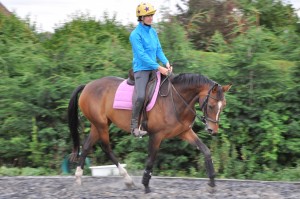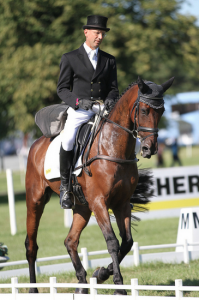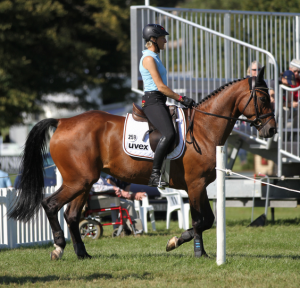(Kerry : I met Matt Jeffery when I went to take photos of Francis Whittington having a fitness test and running shoes fitted, when he was invited onto the Rider Secrets regime, along with Sharon Hunt and Oliver Townend. Recently I asked Matt whether he had some advice for lower level riders, based on his findings over the ensuing months with these elite riders, and his extensive knowledge of fitness training.)
Training for Riding – You not the Horse!
Matt Jeffery BA (Hons) QTS Phys Ed, Associate member UKSCA, Rider Secrets’ trainer.
For the first article on Training for Riding I thought I’d shed a bit of light on the proper definition of fitness, as it is a subject that is often misunderstood. We’ll also take a look at how it relates to riding.
The term ‘fitness’ can basically be broken down into nine elements:
Strength, Power, Agility, Balance, Flexibility, Local Muscle Endurance, Cardiovascular Endurance, Strength Endurance & Co-Ordination (Tancred, 1995)

This is me (Kerry): not a terrible position, but my shoulders are rolled forward, as they always do unless I concentrate on them and nothing else! SO infuriating!
When we think about fitness as being comprised of these different elements it should begin to make you think about what you do to develop each element in your training for your riding. All of the above elements are tested in eventing and a weak link can mean the difference between a podium or middle-of-the-pack finish. Horse error aside, we are quick to blame a mistake on the rider, however, it would be interesting to know how many times those mistakes were actually triggered by physical fatigue affecting the rider’s decision making. Let’s take a look at some other possible examples. Perhaps poor rider positioning on the horse going into a jump was brought about by a lack of positional awareness due to poor balance. Perhaps a lack of strength endurance in the legs meant the rider couldn’t adjust their position quickly enough and the horse was unbalanced while jumping. Maybe a mistake in the dressage was brought about by a lack of mobility or control in the rider’s pelvis. There are many more occasions when the physical condition of the rider can directly affect the rider’s decision making or the performance of the horse. The good news is that all of the elements can be trained and we can improve each of them.
Fitness for riding isn’t just about going out for a regular run. The correct exercises applied at the right times can greatly enhance your riding capability and performance. A good exercise programme should address the key weaknesses early on, for example if you’re experiencing pain then you should seek medical advice first and foremost. Once you’re pain-free you can begin to develop your fitness in a meaningful way.
Let’s take a look at one key area in physical health: posture. If you’re passionate about your riding you probably spend a lot of time in the saddle. Just like any activity in life, the more time you spend doing the activity the more likely you are to develop movement patterns specific to it. For example, truck drivers and office workers often develop bad backs due to a combination of poor posture and inactivity while seated for long periods of time. In reality it is a combination of certain muscles losing strength and others getting tight, thus limiting motion around several joints.
Riders are no exception: while up and out of the saddle in a canter or gallop the calf muscles (back of the lower leg), quadriceps (thighs), hamstrings (back of the upper leg), glutes (bum), back and neck are all working hard to absorb the motion of the horse, the forces are multiplied if jumping is involved. Add in your forward (from upright) head position (that dramatically increases the load on the muscles in the back of your neck) and the internal rotation at the shoulder caused by the arms reaching in front of the body, and prolonged time in the saddle can lead to muscle fatigue and tightness across most of the body.
Over weeks, months and years consecutively, this stress can begin to alter the alignment of your posture without you even realising. Ever wondered why your riding coach keeps shouting at you to “keep your shoulders back” when you thought you were? Maybe the body positions you adopt on a daily basis and habits you have developed over time coupled with your regular bouts of riding are the reason why your shoulders are rounded and your back isn’t straight. Maybe that’s the reason why you lost a couple of points in the last dressage for poor ‘rider position and correctness.’ If your posture is one with rounded upper back and shoulders then no matter how much you keep saying to yourself ‘shoulders back’ as soon as you get mentally distracted your body will revert to type and for those few seconds while the judge looks at your riding position on the horse you may lose your podium finish.
However, all is not lost. An exercise programme that incorporates flexibility for the tight muscles and strengthening exercises for your weaker muscles can have a dramatic impact on your posture, leading to improved rider position. The exercises will also have benefits relating to the other elements of fitness.
In future articles we’ll take a look into how these other elements of fitness influence your riding, and how they can be worked on to ensure you give yourself every chance of improving your riding.
Enjoy your riding,
Matt
Photos of Pro riders by Katie Mortimore.





